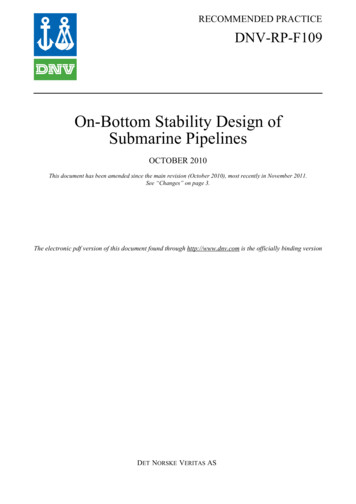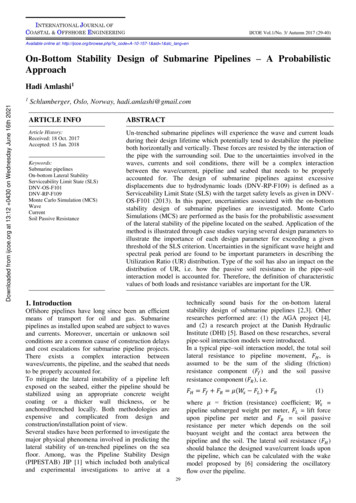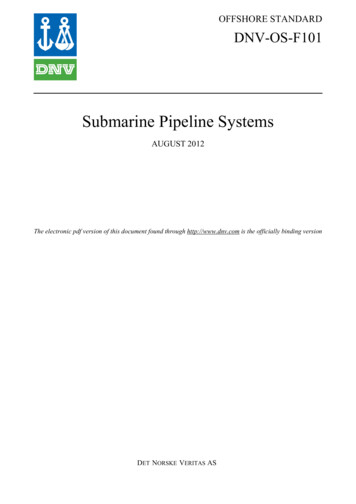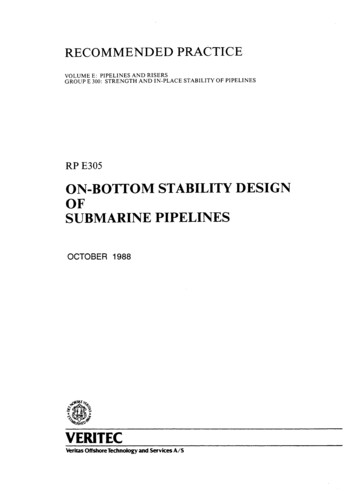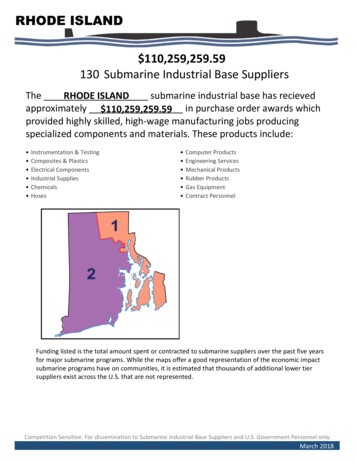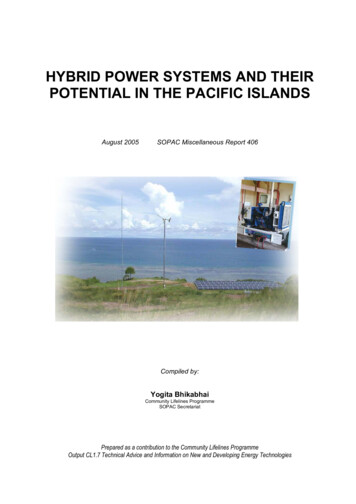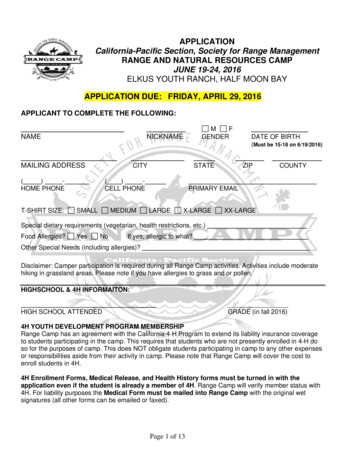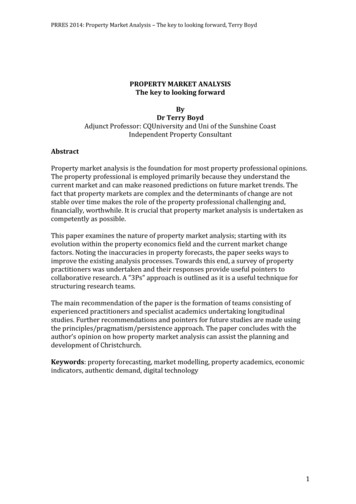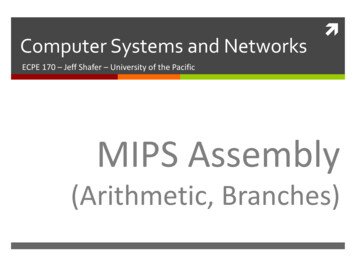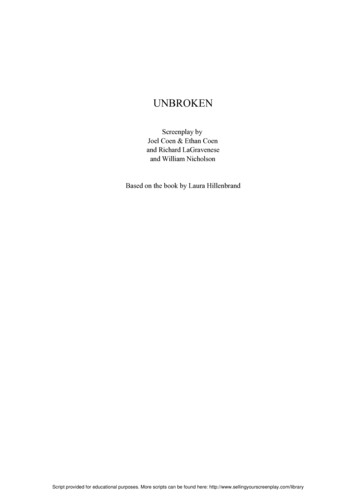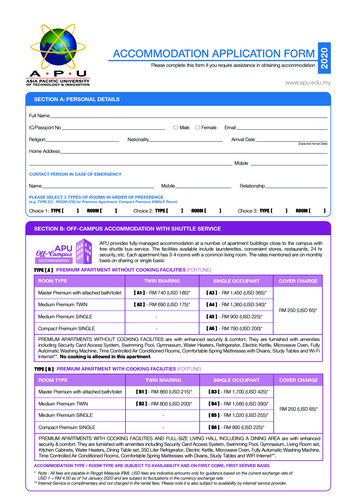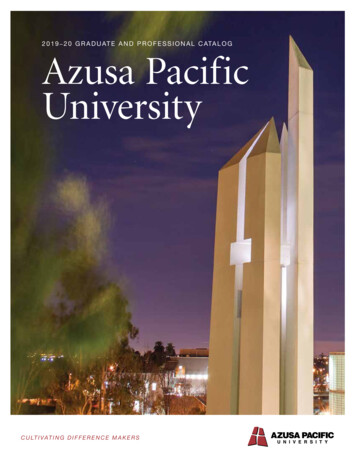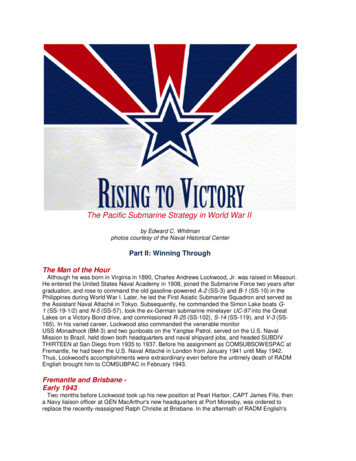
Transcription
The Pacific Submarine Strategy in World War IIby Edward C. Whitmanphotos courtesy of the Naval Historical CenterPart II: Winning ThroughThe Man of the HourAlthough he was born in Virginia in 1890, Charles Andrews Lockwood, Jr. was raised in Missouri.He entered the United States Naval Academy in 1908, joined the Submarine Force two years aftergraduation, and rose to command the old gasoline-powered A-2 (SS-3) and B-1 (SS-10) in thePhilippines during World War I. Later, he led the First Asiatic Submarine Squadron and served asthe Assistant Naval Attaché in Tokyo. Subsequently, he commanded the Simon Lake boats G1 (SS-19-1/2) and N-5 (SS-57), took the ex-German submarine minelayer UC-97 into the GreatLakes on a Victory Bond drive, and commissioned R-25 (SS-102), S-14 (SS-119), and V-3 (SS165). In his varied career, Lockwood also commanded the venerable monitorUSS Monadnock (BM-3) and two gunboats on the Yangtse Patrol, served on the U.S. NavalMission to Brazil, held down both headquarters and naval shipyard jobs, and headed SUBDIVTHIRTEEN at San Diego from 1935 to 1937. Before his assignment as COMSUBSOWESPAC atFremantle, he had been the U.S. Naval Attaché in London from January 1941 until May 1942.Thus, Lockwood's accomplishments were extraordinary even before the untimely death of RADMEnglish brought him to COMSUBPAC in February 1943.Fremantle and Brisbane Early 1943Two months before Lockwood took up his new position at Pearl Harbor, CAPT James Fife, thena Navy liaison officer at GEN MacArthur's new headquarters at Port Moresby, was ordered toreplace the recently-reassigned Ralph Christie at Brisbane. In the aftermath of RADM English's
death, however, Christie - now a rear admiral - was hurriedly brought back from the NewportTorpedo Station to replace Lockwood at COMSUBSOWESPAC in Fremantle.In response to the demands of the Solomons campaign in late 1942, Brisbane was by then hometo three submarine squadrons - some 20 boats and their associated tenders and support facilities.Between the build-up to the invasion of Guadalcanal in August 1942 and its final pacification inFebruary 1943, the Brisbane boats mounted nearly 60 war patrols, including forays into theSolomon Islands and inter-force transfers to Pearl Harbor by way of Truk and Rabaul. Thisoffensive - largely steered by ULTRA cues into heavily-defended areas - accounted for only twodozen enemy ships, nearly half of those near Truk. Moreover, three of the five boats that leftBrisbane in February were lost to enemy action, leading to an internal investigation of Fife'sleadership. In any event, with the Solomons campaign winding down and the war moving north andwestward, Fife's command would be reduced to only one squadron by mid-1943.During their last several months under Lockwood, the small Fremantle force mounted just over15 war patrols, but a third of these had been devoted to minelaying off Siam and Indochina, andanother third had been associated with transits to Pearl Harbor. Postwar analysis credited 16enemy ships to this effort, but as the only submarines well positioned to interdict the flow ofpetroleum - only lightly protected - from the Dutch East Indies to the Japanese operating bases andhome islands, the Fremantle boats lost a significant opportunity. With Christie, in the first half of1943, this pattern began to change, and half of the Fremantle sorties targeted Japanese convoyroutes to the north and west. 23 sinkings were eventually confirmed - about one per patrol - but twomore boats were lost to the enemy.Seizing the Initiativefrom Pearl HarborWith their failure to retake the eastern Solomons in late 1942, the Japanese turned in 1943 todefending what remained of their earlier conquests. Thus, with new war materiel arriving daily fromthe United States, the Allies quickly regained the initiative, took back Attu and Kiska in May andAugust and - under GEN MacArthur - attacked the northern Solomons and "leap-frogged" westerlyalong the coast of northern New Guinea while isolating and bypassing Rabaul. Late in the year,ADM Nimitz's island-hopping campaign across the central Pacific got under way in earnest with theinvasion of Tarawa and Makin in the Gilbert Islands in November.Accordingly, during 1943 the COMSUBPAC submarine force at Pearl Harbor - now under RADMLockwood - gradually came to predominate over their counterparts in Australia. Because theSolomons action had drawn so many submarines to SOWESPAC, SUBPAC could only muster 28war patrols for the first three months of 1943, and over half were sent to Truk, Palau, and theMarianas.
A notable exception was the first penetration of theYellow Sea in March by USS Wahoo (SS-238) under"Mush" Morton, with a total bag of nine enemy ships.Unfortunately the other Pearl Harbor patrols for thatsame period saw only limited success, at leastpartially because of the high priority placed on hardto-target enemy capital ships. By mid-spring 1943,however, Lockwood's force had grown to 50submarines. Between April and August, he was ableto send an average of 18 to sea each month for warpatrols of 40-50 days, with over half targeted atenemy shipping in Empire waters and the East ChinaSea. A significant innovation occurred in July, whenLockwood and his brilliant Operations Officer CAPT(later RADM) Richard Voge sent three submarinesinto the Sea of Japan, entering from the north throughthe La Pérouse Strait. The three boats only managedto sink three small freighters in four days beforewithdrawing, and two subsequent patrols the nextmonth - one under "Mush" Morton - did little better. InSeptember, however, Morton returned to the Sea ofJapan a second time and apparently sank four shipsbefore Wahoo was lost to a Japanese anti-submarineaircraft in early October while attempting to comeback out.Chosen as COMSUBPAC after the death of RADMEnglish in January 1943, VADM Charles Lockwood "Uncle Charlie" - formulated the strategy that won theU.S. Submarine Force their unprecedented underseavictory in the Pacific. Lockwood's extraordinarysubmarine career had begun with command of A-2(SS3) in the Philippines during World War I.Tackling the Torpedo ProblemMuch of Lockwood's command attention during 1943was consumed by several nagging materiel problems thathad crippled U.S. submarine effectiveness early in the war.Foremost among these was torpedoes - not only ashortage of numbers, but continuing evidence of thedesign defects the admiral had already encountered duringhis tenure as COMSUBSOWESPAC.In April 1942, RADM Ralph Christie (left) was theLockwood's earlier investigations at Fremantle hadfirst commander of the U.S. Submarine Force atestablished that U.S. torpedoes were running too deeply,Brisbane, Australia and becameCOMSUBSOWESPAC at Fremantle in earlybut even when this deficiency was corrected, torpedo1943. RADM James Fife (right) relieved Christieperformance continued to be suspect. Following anat Brisbane in December 1942 and remainedincreasing number of attacks foiled by premature warhead there until March 1944. Then, following anassignment in Washington, Fife relieved RADMexplosions apparently due to a too-sensitive magneticChristie again - asCOMSUBSOWESPAC ininfluence exploder, Lockwood prevailed on ADM Nimitz in December 1944.June 1943 to order the magnetic "pistol" disabled onCOMSUBPAC torpedoes and to rely solely on the contact exploder. But even with the magneticfeature disabled, Pearl Harbor submarines continued to experience a significant percentage of"duds," and it soon emerged that there were also major defects in the contact exploder. This ledLockwood to a series of careful experiments in Hawaii in which torpedoes were fired againstunderwater cliffs to determine potential causes of failure. These revealed that the firing pin was tooslender to withstand the shock of a 90-degree encounter without buckling and "dudding" thetorpedo. When this last piece of the puzzle fell into place in September 1943, performance of theMark XIV submarine torpedo finally reached acceptability, but it had taken literally half the war toget there. That the problem had to be solved in the field by the operators themselves - and in spite
of a technical community that only wanted to minimize the deficiencies - still evokes bittermemories.Moreover, the dubious reliability of the H.O.R. main-propulsion engines - apparent from thebeginning of the war - became even more critical in May 1943 when the twelve boats of SUBRONTWELVE arrived at Pearl Harbor, all fitted with H.O.R. diesels. In both shakedown cruises and theirEuropean service with the Atlantic Fleet, all of the SUBRON TWELVE submarines revealed engineproblems. These only became worse under combat conditions in the Pacific, where virtually all theH.O.R. boats were handicapped by catastrophic breakdowns that often required curtailing warpatrols and returning to base for repairs. One by one, the H.O.R. submarines were shuttled back toMare Island for new Winton engines, but it was nearly a year until all had been returned to duty andthe H.O.R. maintenance problems eliminated.Japanese Supply Lines a New FocusFor the bloody, but successful, invasion of the GilbertIslands in November, a dozen submarines provided directsupport: conducting reconnaissance, landing commandos,performing "lifeguard" duty to pick up downed U.S. pilots,and blockading Truk. During this same period, however,Lockwood and Voge introduced two additional tacticalinnovations: deploying small, coordinated submarine "wolfpacks" as tactical units; and concentrating more antishipping efforts in the Luzon Strait between the northernPhilippines and Formosa, where several Japanese northThe Mark XVIII electric torpedo shown heresouth convoy routes from the conquered territoriesduring loading was slower than the troublesomeMark XIV but left no wake and could be produced converged. The first three three-boat wolf-packs departedin greater quantities. By mid-1944, three-quarters Pearl Harbor in September, October, and December - theof the standard patrol load-out consisted of Markfirst for the East China Sea; the others for the Marianas.XVIIIs.Results were mixed. The first Marianas effort sank sevenships, but the total score for the other two was only four. Even as tactics and techniques improved,communications and coordination among wolf-pack members at sea remained difficult, and "blueon-blue" engagements were a worrisome possibility. Nonetheless, in 1944, wolf-packing becameincreasingly common, particularly for commerce-raiding north of Luzon."The Submarine Force played a key role in the victory not only by providing crucial sighting reports,but by sinking or heavily damaging six enemycombatants."Although both Fremantle and Brisbane maintained a steady level of activity throughout 1943, thelatter steadily lost importance as a submarine base in the later stages of the conflict. Early thatyear, the number of submarines stationed in Australia had been fixed at 20, nominally with 12 atBrisbane under CAPT Fife and eight at Fremantle under RADM Christie. As the war moved up theSolomons chain and westward into New Guinea, the boats were reapportioned in favor ofFremantle, and when the total number of Australia-based submarines was increased to 30 late inthe year, Fremantle was allocated 22 and Brisbane the rest. Fife made the best of this disparity byestablishing an advance base at Milne Bay, New Guinea, 1,200 miles closer to his operating areasoff Truk, Rabaul, and Palau. In the latter half of the year, his 33 war patrols resulted in 29confirmed sinkings along the supply lines linking the three Japanese bases. During that sameperiod, after Japanese tankers were moved up the priority list, Christie's growing force atFremantle turned aggressively to attacking the oil traffic from Borneo and Sumatra. Nearly 50enemy ships were sunk by the Fremantle force between June and December, and a dozen of
these were oil tankers.1943 - the Year of TransitionFor all of 1943, the Submarine Force was credited with sinking 335 Japanese targets - or 1.5million tons of shipping - essentially twice the corresponding figures for 1942. More importantly,after diminishing only slightly in 1942, the total tonnage of the Japanese merchant marine(including oil tankers), dropped 16 percent in 1943, despite a vigorous shipbuilding program not yetdisrupted by Allied air attacks. Correspondingly, the importation of bulk commodities (not includingpetroleum products) into Japan had diminished by the end of 1943 to 81 percent of the pre-warlevel. Surprisingly, though, Japanese tanker tonnage actually increased by nearly 30 percent overthe year due to need to transport oil from the East Indies.Starting in mid-1943, the gradual introduction of the Mark XVIII electric torpedo into the theaterbrought substantial relief from the persistent torpedo shortages of the early war years. Althoughslower than the Mark XIV by 10 to 15 knots and somewhat limited in range, the Mark XVIII left notell-tale wake that could give away a submarine's position, and it was much easier to manufacturein quantity. By the middle of 1944, when all their teething problems had been solved, Mark XVIIItorpedoes constituted three-quarters of the standard patrol load-out. Despite the large percentageof U.S. war patrols targeted specifically at major Japanese bases or cued against Japanesecombatants by ULTRA information, U.S. submarines sank only one major Japanese warship in1943 - the light aircraft carrier IJS Chuyo. That same year, fifteen U.S. submarines were lost in thePacific - plus two in the Atlantic. The Japanese lost 23.As the number of war patrols from PearlHarbor, Fremantle, and Brisbane mountedin 1943 and 1944, the percentage ofJapanese merchant tonnage remainingafloat dropped relentlessly from its pre-warlevel. Of note id the peak of U.S. submarineactivity in May 1942 in preparation for theBattle of Midway.Thrusting Westward Early 1944By the time ADM Nimitz's cross-Pacific thrust reached the Marsha
"Uncle Charlie" - formulated the strategy that won the U.S. Submarine Force their unprecedented undersea victory in the Pacific. Lockwood's extraordinary submarine career had begun with command of A-2(SS-3) in the Philippines during World War I. In April 1942, RADM Ralph Christie (left) was the first commander of the U.S. Submarine Force at
